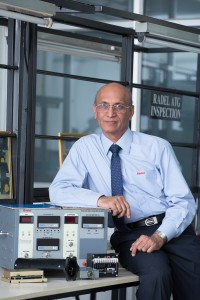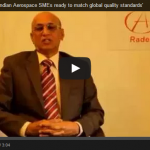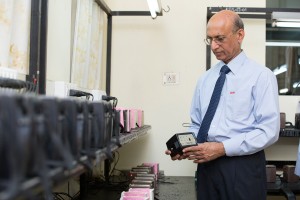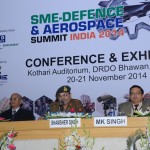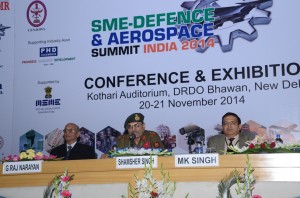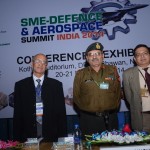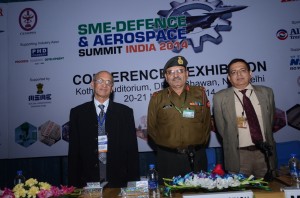CHALLENG ES FOR MAKE IN INDIA IN THE A&D SECTOR
ES FOR MAKE IN INDIA IN THE A&D SECTOR
The ‘Make in India’ campaign seems to focus on ‘Build to print’ as per drawings supplied by a foreign OEM. While this may provide some short-term benefits, it will not lead to self-reliance in the long term. Experts in the A&D arena have openly acknowledged that the so-called ‘Transfer of Technology’ has never resulted in any provision of core technology other than basic manufacturing and maintenance documents. To be truly self-sufficient in this critical sector, we need to Create, Innovate, Design, and Manufacture in India through indigenous R&D.
Any entrepreneur desiring to design and manufacture for the A&D sector faces many challenges. These are:
Internal:
- Lack of specialised domain knowledge and awareness of the stringent quality standards and military This is a result of the historical confinement of the domain within DPSUs for the last six decades with no access to the private sector.
- Capability to design equipment to overcome harsh conditions imposed by extremes of temperature, humidity, altitude, vibrations, corrosive atmosphere, etc.
- Competence to engage in technical discussions with certification authorities.
- Multi-disciplinary domain knowledge that is essential for holistic design and manufacture.
External
- Delays in all processes up to several years for even a small project. Tender bids are required to be valid for at least six months and often for 12 months.
- Small volumes leading to problems in sourcing specialised components at competitive prices.
- Uncertainty about future production orders for an indigenisation product.
- Availability of trained workforce
While the responsibility to develop competency in the domain rests with the entrepreneur, the external challenges above are detailed as follows:
RFQ and tender stage:
One of the greatest challenges relates to lack of ownership and decision making in the DPSUs and the Armed Services. It often takes two years for a requirement to mature to an RFQ, even for ‘critically required’ LRUs, sub-assemblies and spare parts. The subsequent process of tender evaluation, price negotiation and order release takes at least 6 months. In many cases, orders are not released even after the L1 vendor has attended price negotiation meetings. These are highly demotivating to an entrepreneur. In most cases, technical specifications of the OEM equipment are not even available with the tendering agency and the RFQ states ‘Generation of technical specifications is a part of the indigenisation process’. If this is so, how does a bidder specify what he would deliver and how does the tendering agency evaluate the bid?
Small volumes
In most cases, annual quantities of specialised parts and equipment are in single digits. This makes purchase of specialised, military grade raw materials and components very difficult. These include even screws, nuts, washers, consumables, etc., that are used on airborne equipment. This imposes either very high costs on a small quantity, or a large inventory of unused materials.
Qualification Testing
- Before the indigenised unit can be integrated into a military platform, it needs to be qualified by subjecting it to stringent life-cycle tests. This includes expensive EMI/EMC and Environmental testing that is only carried out in a few specially equipped laboratories. These tests can by themselves cost anywhere from Rs.6 to 10 lakhs.
- Qualification tests are to be conducted in Govt. approved test agencies. While large corporates are able to afford investments in expensive test facilities within their organisation, MSMEs find it unaffordable. MSMEs therefore have to rely on external service providers such as DRDO or DPSUs. Time slots at such external agencies are very difficult to obtain for a private company. This hurts the progress of the projects leading to cost escalation. Reputed test houses in the private sector are far more expensive than govt. controlled agencies.
Serial Production
There have been many instances where no production orders have been placed after indigenous development of even a ‘critically required’ item that has been designed, tested and qualified by a vendor. This is a complete let down and one of the demotivators for design entrepreneurs to enter this sector.
Funding and cash flow
Funding for long gestation A&D development projects is just not available. Indian banks and funding agencies do not appreciate the value of research, design and development. While the present Indian Govt. has proposed to set up a Defence R&D Fund for MSMEs, the modalities of making this available to genuine entrepreneurs is yet to be formalised.
Availability of trained workforce
Trained workforce, especially design engineers, are simply not available due to disconnect between industry and the academia. This is even more severe in the specialised A&D sector.
Conclusions & Suggestions:
- DRDO and DPSUs should facilitate domain specific knowledge sharing with A&D MSMEs to empower them to appreciate the intricacies and challenges of indigenous development.
- Funding mechanisms for long gestation D&D projects need to be created on priority since this involves self-reliance in defence and aerospace. One method could be the award of rating points (similar to credit rating by CIBIL), proportional to the value of A&D related orders successfully executed by an MSME. The accumulation of points would indicate the maturity and capability of the vendor. These could be accumulated and monetised for obtaining special financing from Public Sector Banks, as well as for proportional reduction of monetary Performance Guarantees to the customers.
- Establishment of virtual clusters of MSMEs linked to larger private companies or DPSUs/DRDO will result in an organised growth of MSMEs with specialised aerospace domain knowledge that can ultimately lead to complete indigenous equipment and systems development capability over time.
- The same ecosystem can then be leveraged by the educational institutions for teaching as well as training the graduates in the field of A&D, within industries on live projects. Engineering colleges today teach the aeronautical subjects without even a physical contact with a live aircraft or engine.
- Materials Bank to be established for easy availability of commonly used military grade raw materials and standard parts for MSMEs.
- Establishing testing labs by the Government, exclusively for use by private MSMEs or by directing a priority allotment of time slots at govt. labs.
- Excise duties, Service Tax and VAT (GST) should be exempted for all related inputs as well as the final product/services. It does not make any sense for duties and taxes to be paid from one Govt. account to another through the intermediary private vendor who has to also deal with the cash flow issue.
There is no dearth of technology and competencies among Indian private sector industries in undertaking challenging indigenisation projects. All they need is a friendly and supportive induction into the sector.
The original article appeared in the Defexpo 2016 Show Daily of Geopolitics Magazine on March 30, 2016.



